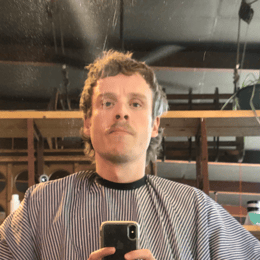The most authoritative answer in 2024
-
As a subject matter expert in the field of biochemistry and molecular biology, I've spent a considerable amount of time studying the intricate structure and composition of hair. Hair is a fascinating biological structure that serves a multitude of functions, from providing insulation to aiding in sensory perception. At the core of hair's structure is a protein known as keratin, which is responsible for the hair's strength and resilience.
Keratin is a fibrous structural protein that is found in several different types of tissues throughout the body. It is particularly abundant in hair, nails, and the outer layer of the skin. The follicle, a tiny sac-like structure beneath the skin's surface, is the site where hair growth begins. Within the follicle, cells known as matrix cells are responsible for the production of keratin.
The process of hair formation involves the differentiation of these matrix cells, which eventually harden and die, becoming part of the hair shaft. The hair shaft is the visible part of the hair that we see, and it is composed of a complex arrangement of keratin proteins. These proteins are unique in that they contain a high number of sulfur atoms, which play a crucial role in determining the hair's texture.
When discussing the curliness of hair, we must delve into the chemistry of these sulfur atoms. The disulfide bonds are a key factor in this. These bonds are covalent linkages that form between two sulfur atoms, typically from two different keratin molecules. The formation of disulfide bonds is a critical step in the process of keratinization, which is the transformation of the soft, living cells of the hair follicle into the hard, durable structure of the hair shaft.
The curvature of hair is influenced by the distribution and the pattern of these disulfide bonds. In straight hair, disulfide bonds are predominantly found within the same keratin molecule, creating a relatively smooth and linear structure. In contrast, in curly hair, these bonds are more likely to occur between different keratin molecules, which can cause the hair to bend or curl. This is because the formation of intermolecular disulfide bonds effectively links different parts of the hair shaft together, creating a kink or curl.
It's also important to note that the cysteine, an amino acid rich in sulfur, is particularly important in the formation of these disulfide bonds. The presence of cysteine in the keratin protein chain allows for the possibility of forming these cross-links, which are essential for the hair's structural integrity and shape.
In addition to the structural role of keratin and disulfide bonds, other factors can influence hair texture. These include the hair's cuticle, which is the outer protective layer made up of overlapping cells. The condition and health of the cuticle can affect how the hair reflects light and its overall appearance. Furthermore, the cultural and environmental factors such as hair care practices, humidity, and use of heat-styling tools can also have an impact on hair's perceived curliness.
Understanding the protein chemistry of hair is not just an academic exercise; it has practical implications for the hair care industry. Knowledge of how keratin and disulfide bonds contribute to hair's structure can inform the development of hair care products that aim to improve hair health, manageability, and styling options.
In conclusion, the curliness of hair is a result of the complex interplay between the structural protein keratin, the presence of sulfur atoms, and the formation of disulfide bonds. This intricate molecular arrangement gives hair its characteristic texture and shape, which can range from straight to wavy to tightly curled.
read more >>+149932024-05-14 18:40:49 -

-
Lucas Scott——Works at Facebook, Lives in Menlo Park. Holds a degree in Computer Engineering from Stanford University.
Hair is made up of a protein called keratin that grows from a sac called the follicle. Cells in the follicle that produce keratin and other proteins become apart of the hair shaft. These proteins contain sulfur atoms. When two or more of these sulfur atoms pair up, they form what is called a disulfide bond.Feb 17, 2014read more >>+119962023-06-15 19:47:01
About “头发、自然、蛋白质”,people ask:
- 93回复Can you wet your hair before a relaxer??
- 45回复Can you get your hair wet after a perm??
- 72回复Is coarse hair thick??
- 58回复How can a black boy get curly hair??
- 72回复Why did my straight hair turn curly??
- 73回复What products to use for a perm??
- 87回复What is a plop for hair??
- 45回复What is a pineapple ponytail??
- 49回复How do you keep curls in overnight??
- 69回复Why do some people have curly hair??
- 58回复Why do some people have curly hair??
- 26回复Do perms make your hair fall out??
- 20回复What determines the type of hair you have??
- 66回复Can you get your hair wet after a perm??
- 60回复What makes hair curly protein??
READ MORE:
- +1166Are perms bad for hair?
- +1290What is a plop for hair?
- +1712Can nicotine be detected in hair?
- +1165Is alcohol detected in a hair follicle test?
- +1548Can acid stay in your spine?
- +1315How long does Molly stay in your hair follicles?
- +1302Is Molly highly addictive?
- +1236How long does it take for a pill to wear off?
- +1642Is it OK to use body wash on your hair?
- +1476How contagious is folliculitis?
- +1748How do you get rid of folliculitis at home?
- +1612What does it mean when a drug test is non negative?
- +1224Is it good to test negative on a drug test?
- +1830How long do you have to detox?
- +1919How much weight do you lose when you drink apple cider vinegar?
QuesHub is a place where questions meet answers, it is more authentic than Quora, but you still need to discern the answers provided by the respondents.







